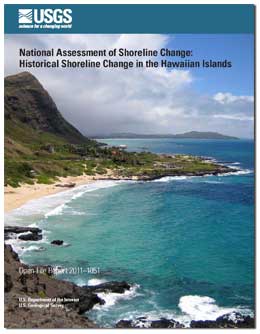Open-File Report 2011-1051
Introduction
Sandy beaches of the United States are some of the most popular tourist and recreational destinations. Coastal property constitutes some of the most valuable real estate in the country. Beaches are an ephemeral environment between water and land with unique and fragile natural ecosystems that have evolved in equilibrium with the ever-changing winds, waves, and water levels. Beachfront lands are the site of intense residential and commercial development even though they are highly vulnerable to several natural hazards, including marine inundation, flooding and drainage problems, effects of storms, sea-level rise, and coastal erosion. Because the U.S. population continues to shift toward the coast where valuable coastal property is vulnerable to erosion, the U.S. Geological Survey (USGS) is conducting a national assessment of coastal change. One aspect of this effort, the National Assessment of Shoreline Change, uses shoreline position as a proxy for coastal change because shoreline position is one of the most commonly monitored indicators of environmental change (for example, Fletcher, 1992; Dolan and others, 1991; Douglas and others, 1998; Galgano and others, 1998). Additionally, the National Research Council (1990) recommended the use of historical shoreline analysis in the absence of a widely accepted model of shoreline change. A principal purpose of the USGS shoreline change research is to develop a common methodology so that shoreline change analyses for the continental U.S., portions of Hawaii, and Alaska can be updated periodically in a consistent and systematic manner. The primary objectives of this study were to (1) develop and implement improved methods of assessing and monitoring shoreline movement, and (2) improve current understanding of the processes controlling shoreline movement. Achieving these ongoing long-term objectives requires research that (1) examines the original sources of shoreline data (for example, maps, air photos, global positioning system (GPS), Light Detection and Ranging (lidar)); (2) evaluates the utility of different shoreline proxies (for example, geomorphic feature, water mark, tidal datum, elevation), including the errors associated with each; (3) investigates bias and potential errors associated with integrating different shoreline proxies from different sources; (4) develops standard, uniform methods of shoreline change analysis; (5) examines the effects of human activities on shoreline movement and rates of change; and (6) investigates alternative mathematical methods for calculating historical rates of change and uncertainties associated with them. This report summarizes historical shoreline changes on the three most densely populated islands of the eight main Hawaiian Islands: Kauai, Oahu, and Maui. The report emphasizes the hazard from “chronic” (decades to centuries) erosion at regional scales and strives to relate this hazard to the body of knowledge regarding coastal geology of Hawaii because of its potential impact on natural resources, the economy, and society. Results are organized by coastal regions (island side) and sub-regions (common littoral characteristics). This report of Hawaii coasts is part of a series of reports that include text summarizing methods, results, and implications of the results. In addition, geographic information system (GIS) data used in the analyses are made available for download (Romine and others, 2012). The rates of shoreline change and products presented in this report are not intended for site-specific analysis of shoreline movement, nor are they intended to replace any official source of shoreline change information identified by local or State government agencies, or other Federal entities that are used for regulatory purposes. Rates of shoreline change presented herein may differ from other published rates, and differences do not necessarily indicate that the other rates are inaccurate. Some discrepancies are to be expected, considering the many possible ways of determining shoreline positions and rates of change, and the inherent uncertainty in calculating these rates. Rates of shoreline change presented in this report represent shoreline movement under past conditions and are not intended for use in predicting future shoreline positions or future rates of shoreline change. |
First posted May 1, 2012
For additional information contact: Part or all of this report is presented in Portable Document Format (PDF); the latest version of Adobe Reader or similar software is required to view it. Download the latest version of Adobe Reader, free of charge. |
Fletcher, C.H., Romine, B.M., Genz, A.S., Barbee, M.M., Dyer, Matthew, Anderson, T.R., Lim, S.C., Vitousek, Sean, Bochicchio, Christopher, and Richmond, B.M., 2012, National assessment of shoreline change: Historical shoreline change in the Hawaiian Islands: U.S. Geological Survey Open-File Report 2011–1051, 55 p. (Also available at https://pubs.usgs.gov/of/2011/1051.)
Introduction
U.S. Geological Survey National Assessment of Shoreline Change
The Role of State and Federal Governments
Prior National and Hawaii Shoreline Assessments
Environmental Framework of the Hawaiian Shoreline
Carbonate Geology
Beach Sediments
Sea Level
Waves
Tides
Shoreline Change
Methods of Analyzing Shoreline Change
Compilation of Historical Shorelines
Mapping Historical Shorelines
Uncertainty and Error
Calculation and Presentation of Rates of Change
Historical Shoreline Change Analysis
Kauai
North Kauai
East Kauai
South Kauai
West Kauai
Oahu
North Oahu
East Oahu
South Oahu
West Oahu
Maui
North Maui
Kihei Maui
West Maui
Discussion and Additional Considerations
Summary of Shoreline Changes
Influences of Human Activities
Planned Updates and Related Research
Acknowledgments
References Cited